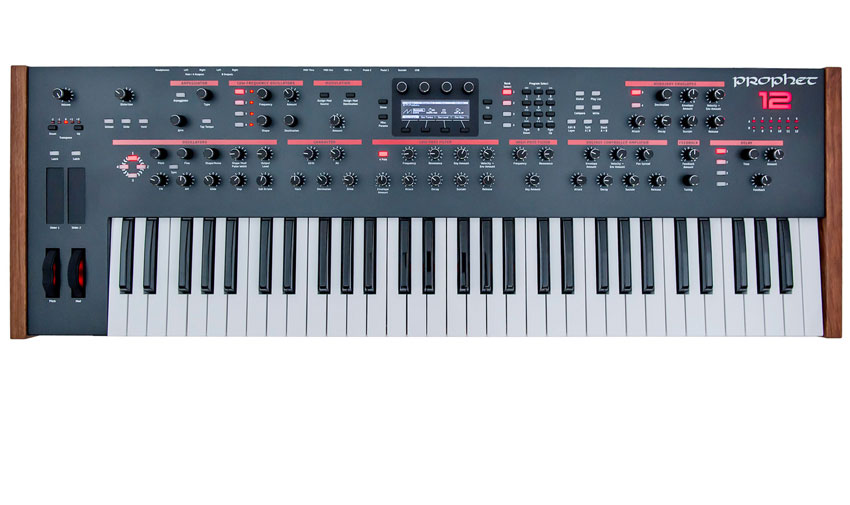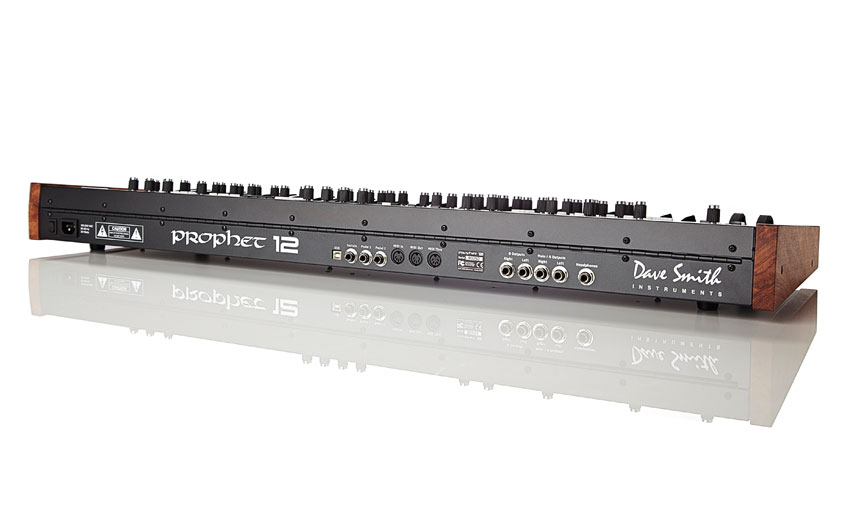MusicRadar Verdict
A deep-yet-intuitive synth that's killer live and in the studio. Inspiring and addictive.
Pros
- +
Unique sound and feature set. Looks great and well built. Very intuitive and sonically versatile.
Cons
- -
Can't specify the exact number of voices in unison mode.
MusicRadar's got your back

DSI Prophet 12

DSI Prophet 12 - rear
The Prophet 12 is DSI's first new Prophet since the Prophet 08 was launched in 2007. However, unlike the P08 (which uses digitally controlled analogue Oscs), the P12 uses powerful Sharc DSPs to produce new high-resolution, anti-aliasing digital waves.
At its heart are 12 voices (with four digital oscillators per voice, plus a single sine sub osc) and a completely analogue signal path from the filters to the outputs - so the P12 really has more in common with the Prophet VS (1986) and the Evolver line, than with the P08.
"There's plenty of weighty wood to offset the dark metal casework and it certainly feels like a flagship product"
DSI's latest creation looks imposing with its ARP Quadra-style orange livery, red backlit wheels and glowing P12 sign. The excellent OLED display from the Tempest features, too, (much better than the red screen on the P08), conveying information elegantly at any viewing angle. There's also plenty of weighty wood to offset the dark metal casework and it certainly feels like a flagship product.
The influence of the Tempest is further felt with the re-appearance of its fantastic touch sliders, which can be assigned to most functions. These are both pressure- and position-sensitive and really add an extra dimension to live performances.
The knobs and switches feel very similar to this reviewer's P08 PE, but build quality feels a notch better and it's good to have the wheels to the left of the keyboard again, rather than on the top panel. Notably, the keyboard feels very high quality - it's fast to play and the aftertouch response feels great.
Deep Yet Intuitive
In use, the P12 is a dream to play and work with, more so than any other synth we've encountered recently. It's very quick to learn and get around for such a complex synth and it's much more intuitive than the P08 or Alesis Andromeda. This enables you to concentrate on performing rather than programming and even when you're deep in it, everything flows logically.
"Hold down LFO button 1, or Osc button 1 and you can tweak several related parameters at once - very cool indeed"
There are some great editing shortcuts, too. Hold down LFO button 1, or Osc button 1 and you can tweak several related parameters at once - very cool indeed. Setting up mod routings is also a breeze: press Assign Mod Source and turn or tap the source, then press Assign Mod Dest and turn or tap the destination and you're set. If you prefer to get into more detailed routing, then you can use the screen/ mod matrix/dials to assign mod sources, destinations and amounts.
The P12 is very well spec'd in the mod department, too, with eight fixed-source mod slots for the most commonly used routings (mod wheel to pitch mod, aftertouch to filter etc) and 16 user-configurable slots with 26 sources and 97 destinations. It's particularly fun modulating delay time or osc shape via aftertouch or the LFOs, or modulating one osc via another, but due to the slick OS design (similar to the Tempest OS) you never feel lost and even novices should gel with it quickly.
Everything you would expect from an analogue synth is onboard, such as unison, sync, glide/trigger modes and detuning. Plus, there's a 'hold' button that sustains sounds (great for making drones or double-handed tweaking). I'd like to see a Memorymoog/A6-style chord mode implemented, too.
One caveat is you can't specify the exact number of voices in unison mode - it's either one voice or 'all'. The same goes for making splits or stacks - the P12 splits the 12 voices equally per layer (so six voices each side of a split or stack unless you go mono on one or both layers) but it would be useful to be able to user-define the specific voice allocation.
Regardless, as the P12 is bi-timbral you have access to two sounds independently in any patch (each with full polyphony) though in OS1.0.0, the P12 will only receive on one MIDI channel. This means you can't control one layer from an external MIDI board - yet.
Also, on a board this price, it would have been nice to have a 12-part multi-mode, but main OS programmer Chris 'PYM' Hector states on the DSI forum that it was a deliberate choice to leave out some of the complexity "to help it stay accessible".
One of the most important controls on the P12 is the 'shape mod' dial, which enables you to smoothly alter the shape of all the onboard waves (much like a pulse width control, but for all the wave types). This works similarly to the variable waveform dial on new Moogs and allows for refreshing new sounds to be built using just the digitised analogue wave types.
Things get particularly interesting when using the shape mod as a mod destination controlled by one of the four LFOs available per voice. The LFOs also have tweakable phase, slew rate and key reset and these parameters can bend and twist the LFO out of shape.
"The P12 is a dream for making evolving soundscapes, drones and mangled sound FX"
In addition, when selecting one of the new digital waveshapes such as 'ahhhh' or 'nasal', you get the option to add another two of these waves into the mix at the same time - so that's up to three complex waves within one oscillator.
You can also crossfade (much like vector synthesis) between these three waveshapes to create continuously evolving textures, harking back to synths such as the Korg Wavestation, PPG Wave and Dave's own SCI Prophet VS. And, as internal control voltages are running at audio rates, the main oscillators can modulate analog parameters. Hence the mod matrix allows the P12 to behave like a modular synth, but with 12 voices and programmability.
It's not surprising therefore that the P12 is a dream for making evolving soundscapes, drones and mangled sound FX.
Filter Flavours
Like the P08, the tasty Curtis low-pass filter is included (with two-pole and four-pole modes) but now alongside it is the analogue high-pass filter from the Tempest, with an added resonance control (though it doesn't self-oscillate). This adds another indispensable flavour to the P12's already broad palette.
The two filters are configured in serial (and currently there's no way to put them in parallel) but when used in conjunction with the low-pass, you can get all manner of great band-pass-type sounds and more besides, much like you can on a Korg MS20, Moog Voyager or Alesis Andromeda.
Both filters have that typical DSI upfront sound, but the low-pass sounds sweeter than on the P08. (Dave confirmed to us that the filters have been tweaked to complement the digital oscillators.)
"The P12's overall character is best described as precise, upfront, punchy and organic"
The P12's overall character is best described as precise, upfront, punchy and organic. From low-filtered background pads and sizzling strings to fat basses, industrial clangorous tones, authentic FM four-op sounds, sweet bubbling arpeggiated FX and authentic analogue-style leads, pads and brass. It's a real testament to the quality of the analogue-style waves.
Thankfully, the P12's character is very musical and it should fit well into electronic and more acoustic settings, both live and in the studio. The four loopable DADSR envelopes (two hard-wired to amp and filter, and two user-assignable) are snappy enough, too, and you can get surprisingly punchy bass sounds out of the P12. It would benefit form a bit more Moog-style snap on the attack for certain sounds. This aside, for a polysynth it's great. There's very little it doesn't do convincingly and thus it is a great all-rounder synth.
The Five Characters
Due to the use of digital oscs, the P12 is sonically more flexible than most analogue synths. While it's true that digital oscs are naturally slightly colder sounding, you can easily dial in analogue warmth and texture, giving you the best of both worlds.
Firstly, the 'slop' parameter (which is much more pronounced than on the P08) emulates the drift in pitch you get from some VCOs, but applies it to the digital waves. Then the character section (digital effects) expands things further.
If that isn't enough, there's tunable feedback (which sounds like microphone/amp feedback) for dialing in some very intense musical and atonal effects. There's also a tasty stereo analogue distortion. It first appeared in the Tempest, but on the P12 it's available to both sides of a stack or split in differing amounts.
"The P12 really has it all. It's a sonic chameleon and can do any type of sound you can imagine"
The P12 really has it all. It's a sonic chameleon and can do any type of sound you can imagine, from raw industrial to soft and beautiful. It looks great, adds in FM, AM and digital wave-based synthesis with powerful modulation and couples it all to two excellent analogue filters.
Not forgetting the plethora of real-time controllers (which all transmit/receive MIDI) and the brilliant four-tap digital delay, which can act as a reverb, chorus, phaser and more besides. As a four-operator FM synth the P12 excels too, but it's the intuitive interface where this synth really scores big.
Sure, there are a few surface gripes, such as no global bypass on the delay/character sections (and no module version yet) but all are easily fixable in updates. The price is definitely on the high side, too, but then this is a pretty unique synth, both sonically and feature-wise. I can absolutely see why Dave Smith thinks the P12 is his best synth yet and it could easily become a future classic.
With its latest free update, Ableton has finally turned Note into the app I always wanted it to be
Technically capable, but struggle to make your tunes sound musical? 5 simple music theory hacks to make your tracks stand out
"Despite its size, it delivers impressive audio quality and premium functions as well as featuring a good selection of inspired sounds": Roland GO:Piano 88PX review









